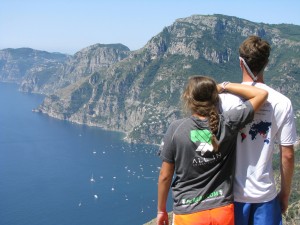Have you ever wondered what in the world the Italian guidebook is talking about when it uses these terms? For years I sort of lumped them all into the same category — “house of worship” — and moved on to more interesting topics. But the distinctions are actually worthwhile information.
Let’s start with basilica. The Latin term has three applications in modern English. The word was originally used to describe an open, Roman, public court building, usually located adjacent to the forum of a Roman town. By extension it was applied to Christian buildings of the same form and continues to be used to describe those buildings with a central nave and aisles. Later, the term came to refer specifically to a large and important church that has been given special ceremonial rights by the Pope.
A cattedrale (cathedral– French cathédrale from Latin cathedra, “seat”) is a Christian church that contains the seat of a bishop, thus serving as the central church of a diocese. Duomo is synonomous with cathedral in Italian, although nowadays it can refer to either a current or former cathedral. The latter could occur if the town no longer has a bishop. And some duomos, although old and important churches, have never actually been cathedrals. The word duomo probably derives from the Latin word “domus”, meaning house, as a cathedral is the “house of God”, or domus Dei.
Finally, chiesa. This is simply Italian for “church”. So if you’re unsure, you can always use this term safely!
Now a word about what may be my favorite chiesa-basilica-duomo-cattedrale in all of Italy: the one in Syracusa, Sicily (pictured above). This phenomenal structure began its life as the magnificent, golden limestone Temple of Athena during the fifth century BC, dominating the acropolis on the highest point of the island of Ortigia (which is the oldest part of Syracusa and a charming destination!). There is some evidence at the site of an even older pagan temple — dating from around 1100 BC, which would correspond to the period of occupation by the Sikel population (who pre-dated even the Phoenicians and the Greeks in Sicily).
The Doric 5th c. temple was clearly an attempt to compete with Athens, the “rival” city that bears Athena’s name and already had a large temple dedicated to her on its acropolis – the Parthenon. In 415 BC, the Athenians launched an unsuccessful invasion of eastern Sicily, coming face-to-face with the temple built in seeming imitation of their own. They were surely humiliated, since by then Syracuse was likely even more prosperous than Athens. In fact, Plato was referring to Syracuse when he suggested Sicily as his model of a utopian society after his visit in 398 BC.
Fast forward to AD 313, when Emperor Constantine granted freedom of religion to Roman citizens. St Paul had already brought Christianity to Syracuse a few decades after Christ’s death, possibly using this very cathedral for the first Christian worship when he spent three days on Ortigia on his way to trial in Rome, after being shipwrecked on Malta for three months. By the 7th century, the first major modifications to convert the temple to a church were underway. The most striking aspect of the Syracuse Cathedral is that most of the original edifice, even its pavement and base set on top of three steps, was left standing. The church was literally built on and around the Doric temple. Most of the temple columns were left standing and many are stunningly visible on the exterior walls. Inside, the wall enclosing the naos (the innermost sanctuary of a Greek temple), has been preserved, though arches were carved into it, forming a nave and two aisles.
The Cathedral of Syracuse gives us a perfect view of how Early Romanesque church architecture evolved. It is overwhelming to arrive from a narrow side alley to the enormous whiter than white Piazza Duomo, then to enter inside this majestic structure and realize that it’s likely been a place of worship for over 3000 years!


